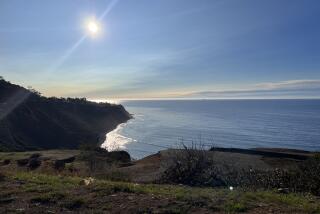Finding New Airport Site an Urgent Matter
One lesson that San Diego learned 10 years ago when a PSA jetliner and a Cessna collided and crashed into a North Park neighborhood, killing 144 people, was that the city had grown too large to allow commercial jets and small, private aircraft to mingle freely in the skies over Lindbergh Field.
As a result of the crash, a more sophisticated air traffic control system was installed and, in spite of protests from private pilots, access to Lindbergh was restricted for small planes. Today, the chance of a similar midair collision is greatly reduced.
A more fundamental lesson, however, has been mostly ignored in the decade since the crash: San Diego has outgrown Lindbergh Field and needs to find a larger, less congested site for its commercial airfield.
Shortly before the crash, then-Mayor Pete Wilson vigorously argued for moving the airport to the city-owned Brown Field in the South Bay. But Wilson was shouted down by public opinion. Convenience won out over foresight.
The crash revived that debate. But even such a tragedy, in which seven people on the ground were killed, failed to motivate the decision makers. A study was conducted outlining alternatives, but all had substantial barriers, and the idea was shelved.
As the city notes the 10th anniversary of the crash, however, the idea of moving the airport is gaining momentum again. The resistance--which neither foresight nor tragedy could overcome--may be giving way to economic reality: Lindbergh is expected to be at capacity in just seven years, and there’s no room to build a second runway.
Renewed debate on alternatives to Lindbergh is long overdue--in practical terms, at least six years overdue because, even if a site were decided on today, it is expected to take 13 years to build an airport. The newest site study has just gotten under way.
The study probably won’t uncover any sites overlooked in two previous studies and will probably find many old objections as strong as ever. The military is still opposed to using Miramar Naval Air Station, North Island or Camp Pendleton; Brown Field is inconvenient for much of the county’s population, and the technology needed to navigate Otay Mountain is still new. Sharing an airport with Tijuana also presents international problems.
Procrastination only steals time, and San Diego cannot afford to lose any more of it. As the city learned by delaying a secondary sewage-treatment plant, there are fewer options as time passes, and the remaining ones become increasingly expensive. Growth already has eliminated one potential airport site, and development is planned near another.
Delay also increases the risk of another tragedy. The city has been unable to prevent buildings from sprouting up in the immediate vicinity of the airport even as the volume of commercial air traffic continues to grow.
The convenience of Lindbergh’s center-city location, once a blessing, is becoming a curse.
New leadership is emerging to push for relocation of the airport. Councilman Ron Roberts and Port Commissioner Louis Wolfsheimer have picked up where Pete Wilson left off. Without public support, though, attempts to find an economical, safer and more intelligent location for the airport may be doomed.
With public support, the barriers to relocation are far less formidable.
More to Read
Sign up for Essential California
The most important California stories and recommendations in your inbox every morning.
You may occasionally receive promotional content from the Los Angeles Times.










